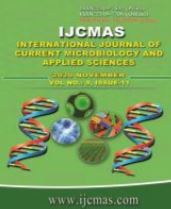


 National Academy of Agricultural Sciences (NAAS)
National Academy of Agricultural Sciences (NAAS)

|
PRINT ISSN : 2319-7692
Online ISSN : 2319-7706 Issues : 12 per year Publisher : Excellent Publishers Email : editorijcmas@gmail.com / submit@ijcmas.com Editor-in-chief: Dr.M.Prakash Index Copernicus ICV 2018: 95.39 NAAS RATING 2020: 5.38 |
Fast development of urbanization alongside other expanding anthropogenic factors have been distinguished as significant reasons of land use changes and land transformations, which eventually presents several devastations like floods, dry season, water contamination and soil debasement. Dissecting the spatial and temporal changes in LULC of basin gives significant understanding to these issues and is one of the analytic strategies to comprehend the issues continuing in a basin. The state of Kerala in particular is notable for significant level of development as far as socio–monetary components, education, human services and so forth are considered. The broad financial changes have prompted expanded pace of framework, building development and abundant scene changes in the most recent decade. The Chalakudy river basin which is in Kerala has been the wellspring of floods since the last recent years and has made a tonne of harms to the basin. For the present study we have compared and analyzed the LULC changes of three different years i.e., 1997, 2007 and 2017. The after effects of the satellite map investigation have demonstrated how urbanization being one of the most significant reasons for LULC changes in the Chalakudy basin has altered the overall basin ecology. It was observed that the vegetation area decreased consequently from 886.21 km2 to 803.09 km2 while the urban area was found to increase from 31.74 km2 to 41.93 km2 (1997-2017). From the net area gain-loss calculation the highest area loss was found to be of vegetation for both the decades with an area of 223.84 km2 and 178.59 km2 respectively.
 |
 |
 |
 |
 |